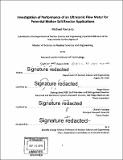| dc.contributor.advisor | Roger Kisner. | en_US |
| dc.contributor.author | Pantano, Michael (Michael Andrew) | en_US |
| dc.contributor.other | Massachusetts Institute of Technology. Department of Nuclear Science and Engineering. | en_US |
| dc.date.accessioned | 2017-09-15T15:27:42Z | |
| dc.date.available | 2017-09-15T15:27:42Z | |
| dc.date.issued | 2016 | en_US |
| dc.identifier.uri | http://hdl.handle.net/1721.1/111291 | |
| dc.description | Thesis: S.M., Massachusetts Institute of Technology, Department of Nuclear Science and Engineering, September 2016. | en_US |
| dc.description | Cataloged from PDF version of thesis. "August 2016." | en_US |
| dc.description | Includes bibliographical references (pages 100-102). | en_US |
| dc.description.abstract | Molten salts for nuclear reactor applications are not a new idea, as these were investigated at Oak Ridge National Lab in the 1960s. However, the past decade or so has seen a large increase in the interest of these, with a variety of designs proposed. The high volumetric heat capacity is of great appeal, as is the low pressure operation with a several hundred degree Celsius margin to boiling. A wide range of passive safety features have also been proposed. However, no matter what the design, there is a need to measure the flow rate of the salt during operation. The nature of the salt greatly complicates the use of a flow meter that must be submerged in the salt. Ultrasonic flow meters have been used for decades with a variety of fluids. These clamp on the outside of the pipe and send an ultrasonic pulse through the pipe from one transducer to another to measure the flow rate. Unfortunately, these have never been used in conjunction with molten salts at the temperatures necessary for nuclear reactor designs. The high temperature of the molten salt presents a problem, as the transducers must be kept cooler. To facilitate this, a thin metal sheet, known as a Wave Injector, was designed to keep the transducer away from the pipe wall and to carry the pulse from the transducer to the pipe. Prior to testing this system on a molten salt facility, it was tested on a water loop to characterize its behavior in a known environment and help inform future design and testing with the molten salt. The bulk of the testing was done in comparing the flow rate measured by the ultrasonic flow meter with that from a reference, electromagnetic flow meter. While the measurements from both agreed well overall, there was significantly better agreement above 7 GPM than below. The ultrasonic flow meter did exhibit good linearity, giving a predictable response for a known change in flow rate. Other testing related to the installation and set-up of the ultrasonic flow meter. Unlike a more traditional flow meter, the ultrasonic flow meter can be configured in a range of ways. It was determined that, as predicted, having the ultrasonic signal take more paths through the fluid produced more precise flow rate data. Additionally, silver was found to be material of choice to go between the piping and the Wave Injector on the molten salt facility, to promote transfer of the pulse from one to the other. These design and configure settings have helped to inform aspects of the molten salt facility, such as tank size. Additionally, testing with and without the Wave Injector provides an anticipation of the spread in data that will be seen on the molten salt facility. Going forward, some additional tests can be done with flowing water to further evaluate configuration options, however the bulk of testing will be with molten salt. Most tests will be similar to those done with the water loop in this study, with either a single path or multipath configuration. Other tests will need to be done to examine the impact of averaging flow rate data on the spread of measurements as well as the loss of temporal resolution. The intended reactor applications should help inform the acceptable resolution in time for safety purposes. Overall, the ultrasonic flow meter performed well and has shown promise with respect to its use as a flow meter for molten salt measurements. | en_US |
| dc.description.statementofresponsibility | by Michael Pantano. | en_US |
| dc.format.extent | 102 pages | en_US |
| dc.language.iso | eng | en_US |
| dc.publisher | Massachusetts Institute of Technology | en_US |
| dc.rights | MIT theses are protected by copyright. They may be viewed, downloaded, or printed from this source but further reproduction or distribution in any format is prohibited without written permission. | en_US |
| dc.rights.uri | http://dspace.mit.edu/handle/1721.1/7582 | en_US |
| dc.subject | Nuclear Science and Engineering. | en_US |
| dc.title | Investigation of performance of an ultrasonic flow meter for potential molten salt reactor applications | en_US |
| dc.type | Thesis | en_US |
| dc.description.degree | S.M. | en_US |
| dc.contributor.department | Massachusetts Institute of Technology. Department of Nuclear Science and Engineering | |
| dc.identifier.oclc | 1002855727 | en_US |
